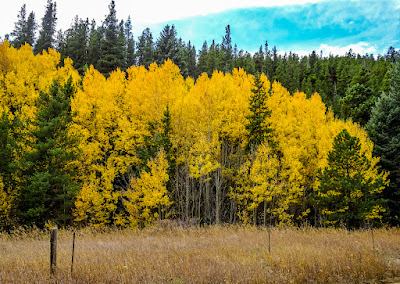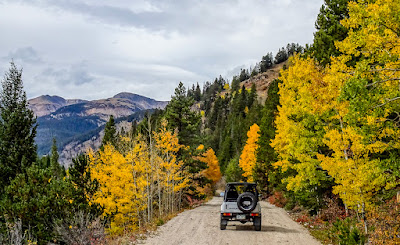In case you were wondering where Scarlett has been....what with all the posts about the Sammy and all...here's one of her with tonight's sunset's colors.
Saturday, October 30, 2021
Thursday, October 28, 2021
Adjusting the Sammy's Carburetor and a new leak presents itself
Not related, mind you, the two events mentioned in the title!
Today, under guidance from RichardM who once again explained the concepts involved with Carburetor Secondaries in a manner which led to my enlightenment, I "adjusted" the setting screw for these on the Sammy.
Background: I had, you see, in my early days of Samurai ownership, messed about with this particular screw, thinking it was the idle adjustment screw, which it was NOT.
I realized this a long time afterwards, while discussing things via messaging with Mike W. Mike is the Samurai Guru I go to as he's rebuilt several and owns two! In the below picture, Mike is using a spare carburetor of his to point to the screw in question.
Saturday, October 23, 2021
Exercising Brigitta and Scarlett Repair Notes
Friday, October 22
Decided to give Brigitta, my '87 BMW R80 Airhead, a good exercise day. We'd end up covering a bit over 160 miles of city/highway riding, including some miles of sandy dirt roads which she and I hated. She's definitely a street motorcycle.
Still, managed to get to, wander around, and return from the Paint Mines Interpretive Park near Calhan, CO without dropping her (came close a couple of times due to deeper than expected sand piles) so I ended up calling it a good day.
Temperatures would "soar" into the high 60s and feel quite warm while hiking about the park but would feel quite cool while riding due to the wind chill factor of course.
Instead of parking in the main parking lot, I ended up parking at the Overlook parking lot which is seemingly closer to the main rock formations.
The picture below shows the main section of colorful rock formation, the overlook parking lot is located above it, but you really have to hike in to view the rocks up close.
Monday, October 18, 2021
Learning about the VRRV's House Battery's capacity.
How little did I really know about batteries and determining their capacities!
Thanks to RichardM, I think I understand the concepts involved much better now, in order to make better decisions as to power usage, power planning and so on.
It all started with the installation of a new battery monitor,
The installation was straightforward and 13 feet of cabling was plenty to be able to mount the display above the VRRV's door.
Subsequent testing revealed that what I thought was the house battery's capacity was way too high/optimistic!
After extensive tests, guided by RichardM, we believe the actual battery capacity of the three year old battery has gone from 114 amp hours when new, to roughly 60 amp hours.
60 amp hours sounds pretty good right? Well, not quite. You can only discharge a Flooded Lead Acid Battery down to 50% to avoid damaging the battery and shortening its lifespan. So really, 30 amp hours is the usable capacity.
The testing showed the battery down to 12.4 volts after "resting" with no load for 90 minutes. When I hooked up the battery to the battery charger, the charger reported 12.4 volts and the meter reported about a 60% charge remaining.
Note: There were five "load" evolutions, resulting in the 22 amps used.
Basing state of charge or SOC using just voltage is an approximate at best method per RichardM and I believe him. So once I get the battery charged up again, I'll the set capacity amp hours at 60 ah on the new monitor and see how that works during further testing/usage.
Concepts learned/re-learned:
You have to wait till a battery has "rested" or had no load/charge for at least one hour before measuring voltage to get the "true" voltage reading.
Reconditioning batteries is something that should be done every other month or so, I'd not done this at all so the battery paid the price in terms of diminishing capacity.
I had to move the negative cable for the inverter to the new shunt, it had been separate before and thereby its energy draw wasn't monitored!
Recurring discharging of the battery down to or close to 50% also hurt the battery's capacity/performance.
Battery monitoring requires very good and tight connections throughout! I discovered loose connections as I installed the new monitor, which probably caused the sporadic abnormal readings with the old battery meter.
Due to the design of the new shunt, had to change the connectors on existing battery cables to fit. I learned that such connectors come with two different hole sizes! Something to be aware of!
The battery fill system I bought back in January of 2017 works great. I found the battery cells all topped off during testing.
Using a Battery Hydrometer Tester is a good thing to do. All six cells on the house battery were in the blue range shown below.
Wednesday, October 13, 2021
Boondocking for a couple of days near Penrose, CO
Felt the need to "escape the cesspool" this past weekend so I drove away from the metro area Monday morning and after a couple of "check out" drives to Red Canyon Park and Oil Well Flats BLM (both north of Cañon City, CO that were unsuccessful, ended up at the usual spot within the Penrose Common Use BLM area.
Note: No cell signal within Red Canyon Park and the roads have gone to shit in several spots leading to the more remote campsites within Oil Well Flats BLM! Not RV friendly at all!
Been here before, many times. It's not a bad site for short rides to Skyline Drive, the Royal Gorge and other venues near Cañon City but it's beginning to lose its "charm" due to over-familiarity I think.
Monday, Oct 11:
After setting up camp, I drove the Sammy to check out the rest of the camping areas, finding only three other campers, two of them looking a bit sketchy but distant from my site so all good.
For instance, there was this abandoned looking wreck of a Class A unit near the entrance to the BLM are:
Wednesday, October 06, 2021
Fall Colors are peaking in the foothills!
Today, I drove my '87 Suzuki Samurai to check out the campsites at the Kelly Dahl Forest Service Campground near Nederland, CO on CO Highway 119; also known as the Peak to Peak Highway.
The Peak to Peak Highway serves as a link from the I-70 Super Slab to Estes Park and the Rocky Mountain National Park. It would take me almost 2.5 hours (left home too early and got caught in the morning rush hours traffic), but made it to the campground with no issues.
The sites are small and would be a tight fit for the VRRV. Note: Sites 1-20 are marked as First Come, First Serve. After the 10th of the month, the campsites are no longer reservable online via rec.gov but the camp host was unsure when they'd close the campsite for the winter.
I wasn't that impressed with the size of the sites so will really have to really think about using this campsite in the future.
Continuing north on CO 119, I soon came to Magnolia Road which I turned off onto and eventually reached the Winiger Ridge Campground area. The roads remain pretty tough for low-clearance vehicles and 4WD is definitely required for some of the more technical spots! Heck, I had to put the Sammy in Low Range for most of the rough portions!
Still, I made it all the way to the end of the FR 529 trail. Only saw two campsites occupied, tent sites of course as no RV I know off would make it to the designated campsites.
Here's some of the Fall Color I posed the Sammy by on the way back to Magnolia Road:

























































